Bricktop’s Cabaret, 1924-34
She was born Ada Beatrice Queen Victoria Louise Virginia Smith to a former slave in West Virginia. Ada “Bricktop” Smith (1894-1984) had a face full of freckles and shocking red hair, hence her nickname. A mixed race bisexual, she was equal parts cabaret entertainer, club operator and matriarch of Montmartre, though she simply called herself “a barkeeper.” Her nightclub became the most popular in Paris for a fashionable set of celebrities, writers and royals.
By 1930 Bricktop’s cabaret was the main attraction in Montmartre for a chic international coterie, drawing songwriters Cole Porter and Noel Coward, writers F. Scott Fitzgerald and John Steinbeck, and the Prince of Wales. Fats Waller and Duke Ellington stopped by on their visits to Paris and Louis Armstrong once sang a duet with Django Reinhardt. Bricktop’s was the “Moveable Feast” that was Paris between the wars celebrated in literature by Ernest Hemingway.
Like Le Grand Duc before it, Bricktop’s played a central role in the black community of Montmartre. Musicians hung out and jammed until early morning hours, black entertainers could receive and send mail, catch-up on gossip or find jobs. And get a down home meal of fried chicken, cooked greens and cornbread.
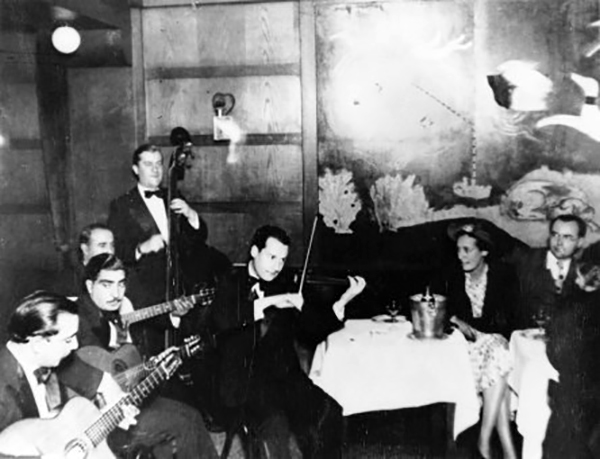
Bricktop’s was the first nightclub to headline the string jazz of Django Reinhardt, Stephane Grappelli and the Quintet of the Hot Club of France. Django is far left.
Her greatest talent was creating an intimate atmosphere and personal rapport with her clientele. Poet laureate of the Harlem Renaissance Langston Hughes (1902-1967), who briefly bussed tables there, profiled Smith in his autobiography:
“Bricktop sang in a cute little voice, with nice, wistful notes. he danced a few cute little steps, tossed her head and smiled, and went around to all the tables and was pleasant to everybody — from guests who could afford only one quart of champagne to those who bought a dozen bottles. French, or American, tourist or diplomat, white or colored, were all the same to Brick. Her professional manner was simply her own manner, in the club or out.”
Bricktop’s cabaret and the nightclubs of Montmartre were the hub of activity for African-American entertainers in Paris — focal point and support system for the small yet cohesive community that hosted African American in France. An informally organized African-American colony welcomed black musicians, entertainers and even boxers to Harlem-on-the-Seine where they could become noted celebrities.
Podcast extras:
01-Early jazz inParis: Alain Romans.mp3 1:46
02-Divas of Montmartre: Snow and Baker.mp3 5:18
03-Harlem on the Seine.mp3 5:15
04-Harlem on the Seine: Coleman, Boudons, Bullards & Decline of Montmartre.mp3 7:43
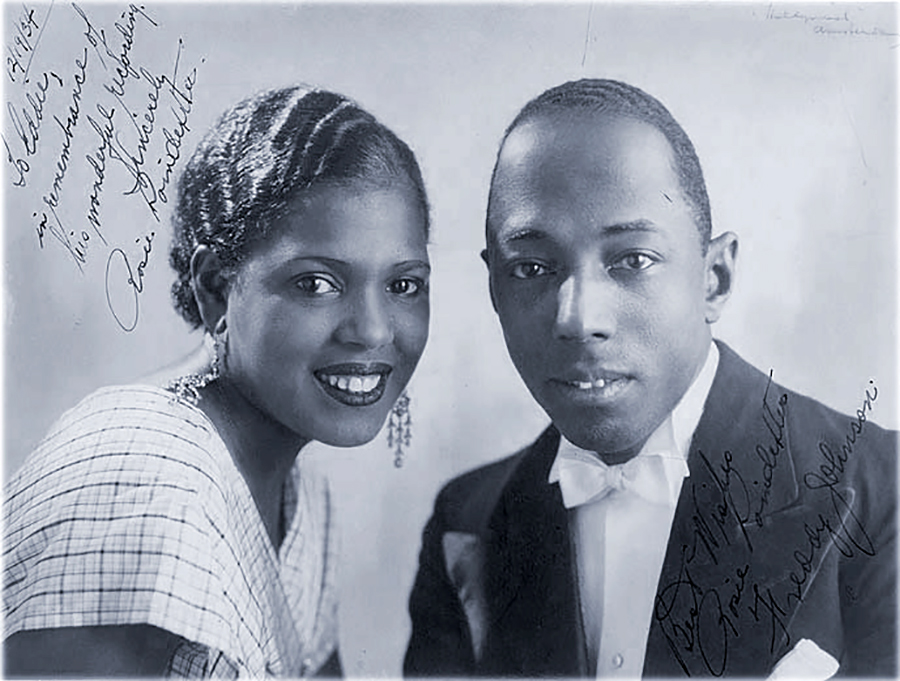
Piano player and bandleader Freddie Johnson with West Indies singer Rosie Poindexter, 1934. Photo: JazzIndex.ch.
Freddy Johnson (piano) and Arthur Briggs (trumpet)
Freddy Johnson (1904-61) was house pianist at Bricktop’s for a few years, as were the excellent swing piano players Garland Wilson and Herman Chittison. An intimate Johnson duet with trumpet player Arthur Briggs, “Japanese Sandman” represents the muted, often hushed music offered at Bricktop’s.
Japanese Sandman, Briggs and Johnson 1933.mp3
A very good musician and singer, Johnson came to Europe with bandleader Sam Wooding in 1928. He stayed, becoming quite successful as a piano soloist and bandleader. Freddy enjoyed great popularity in France, Belgium and Holland, recording with visiting American tenor saxophone master Coleman Hawkins.
Johnson also ran a hot jazz orchestra with the fine trumpet player Arthur Briggs (1899-1991). Briggs was Grenadian-born, of Canadian citizenship and a graduate of the music education offered in the orchestras of the famed Jenkins Orphanage of South Carolina. Living continuously in Europe after 1920, Briggs led or co-led bands, mostly in Paris during the early 1930s and was loosely associated with Johnson. He too, recorded with saxist Hawkins.
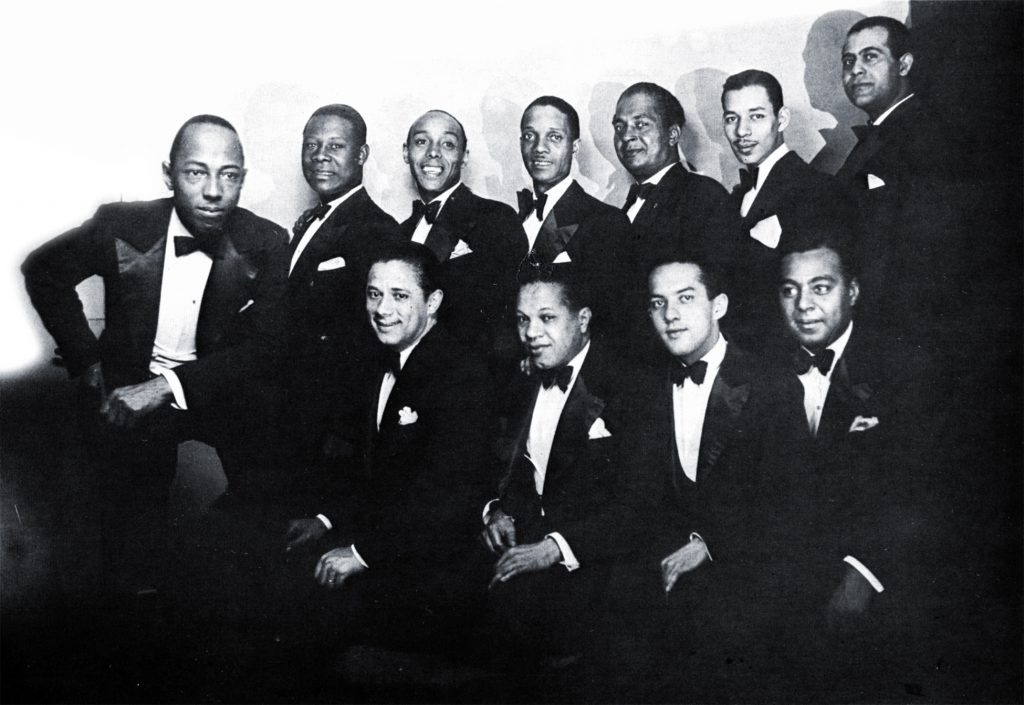
The Johnson-Briggs Orchestra, 1932, standing left: Freddy Johnson and Arthur Briggs, top right: reed player Frank “Big Boy” Goudie.
For a while they shared leadership of a Harlem-style band containing the cream of American jazz musicians in Paris, the hard-swinging Johnson-Briggs Orchestra (aka The Harlemites). The 1933 “Harlem Bound” composed by Johnson was among the finest jazz records made by American musicians in Europe between the wars.
Harlem Bound — Johnson-Briggs Harlemites Orchestra, 1933.mp3
Alberta Hunter
The elegant Alberta Hunter (1895-1984) was a salty Blues, Cabaret and Theatrical performer who led a complicated bisexual lifestyle. Her storied career stretched from the dives and brothels of black vaudeville to the London staging of “Showboat” with Paul Robeson. A pioneering early blues singer, she’d recorded for a half dozen top record labels. Hunter wrote “Downhearted Blues,” Bessie Smith’s first big hit that sold a million records.
Performing frequently in Paris, Hunter was part of the regular crowd at Bricktop’s and the nightclubs of Montmartre. In fact, it’s possible she and Bricktop were intimate. Which is ironic since it was Bricktop who had intercepted the 1924 telegram offering Hunter a job at Le Grand Duc, but taken it herself.
“Miss Otis Regrets:” Alberta Hunter in the Bricktop Manner
Cole Porter’s ironic and bittersweet “Miss Otis Regrets (She’s Unable to Lunch Today)” reflects Bricktop’ distinctive personal cabaret singing style. It’s a cleverly constructed cry against racism and lynching. She never recorded it, nor do we have records of Bricktop in her prime.
But Alberta Hunter’s 1934 performance borrowed some of her style. Yet in the cabaret, unlike this London studio session, Bricktop would have been accompanied by only by a few instruments, piano, or nothing at all. She sang while wandering between tables, interacting with her clientele and staff, or conducting other business.
“Miss Otis Regrets” – Alberta Hunter, 1934
The Decline of Montmartre Nightlife
When the 1929 stock market collapse emptied the pockets of the idle American and British rich in France, Montmartre nightlife fell off. The decline was hastened by the spread of street crime and protests from out-of-work French musicians. The negative side effects of allowing a thriving jazz district eventually provoked a strong reaction from formerly tolerant Parisians.
But by then, top African American singers, orchestras and entertainers were finding more prestigious work outside Montmartre, elsewhere in Paris, on the French Riviera or in Monte Carlo. There were posh gigs in Belgium, Holland, Portugal, Spain and Germany.
Yet it’s doubtful that the jazz heard between the wars in Europe would have been possible without the fearless, bawdy, talented, outrageous and fabulous divas of Harlem-on-the-Seine. They launched “Le Tumulte Noir” and sustained a Golden Age of European Jazz and Swing, 1924-39.
In Part 2, we’ll visit more of the cabarets and nightclubs of Harlem-on-the-Seine where jazz flourished in the 1920s and ‘30s and meet the trumpeter, singer and dancer Valaida Snow who led a flamboyant life in Paris and Europe.
Thanks to Dan Vernhettes for assistance. The story of early jazz continues at the Jazz Rhythm website offering articles, radio programs and free audio at: www.JAZZHOTBigstep.com
Part 2
Bibliography:
Bricktop, Bricktop (Smith, Ada) with James Haskins, Welcome Rain Publishers, 2000
Carisella, P. J. and Ryan, James, W., The Black Swallow of Death: The Incredible Story of Eugene Jacques Bullard, the Worlds First Black Combat Aviator, Marlborough House, 1972.
Chilton, John, Sidney Bechet: The Wizard of Jazz, University of Michigan Press, 1996 .
Coleman, Bill, Trumpet Story, Northeastern University Press, 1989 & 1991.
Flannery, Janet, Paris Was Yesterday: 1925-1939, Viking Press, 1972.
Goddard, Chris, Jazz Away from Home, Paddington, 1979.
Hughes, Langston, The Big Sea: An Autobiography, Hill and Wang, 1993.
Lloyd, Craig, Eugene Bullard: Black Expatriate in Jazz-Age Paris, University of Georgia Press, 2006.
Miller, Mark, High Hat Trumpet and Rhythm: The Life and Music of Valaida Snow, Mercury Press, 2007.
Miller, Mark, Some Hustling This! – Taking Jazz to the World, 1914-29, Mercury Press, 2005.
Shack, William A., Harlem in Montmartre: A Paris Jazz Story Between the Great Wars, University of California Press, 2001.
Stovall, Tyler Edward, Paris Noir: African Americans in the City of Light, Houghton Mifflin, 1996.
Dan Vernhettes, Christine Goudie, Tony Baldwin, BIG BOY: The Life and Times of Frank Goudie, Jazzedit, France, 2015.
- ← Previous page
- (Page 2 of 2)

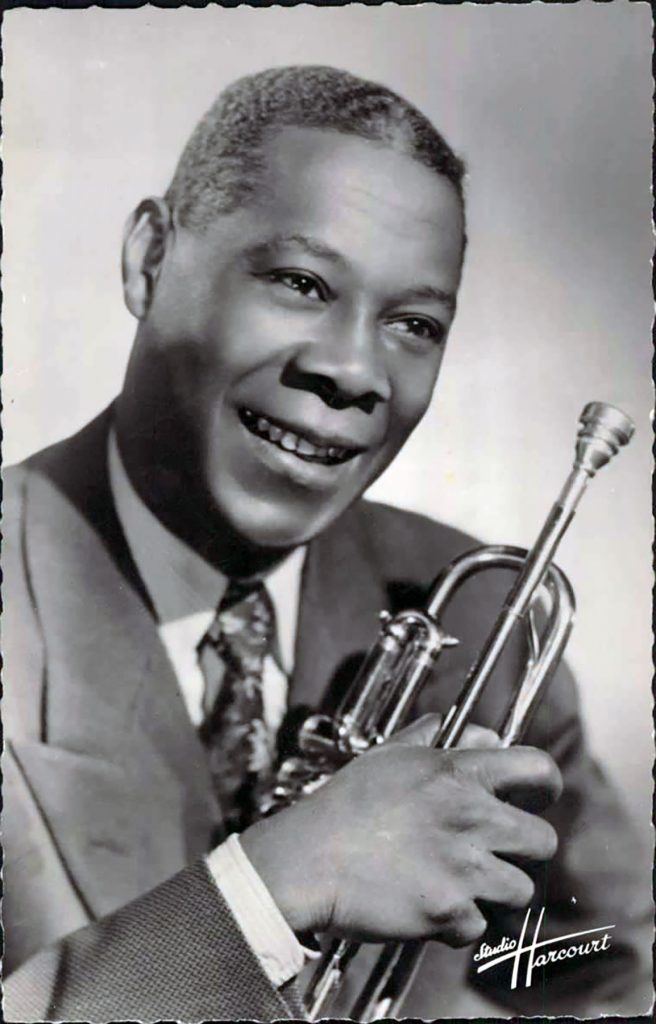
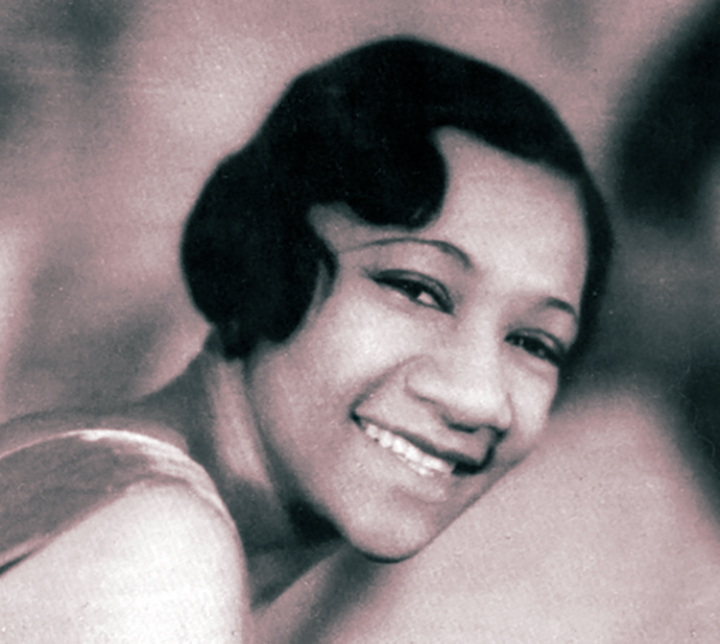
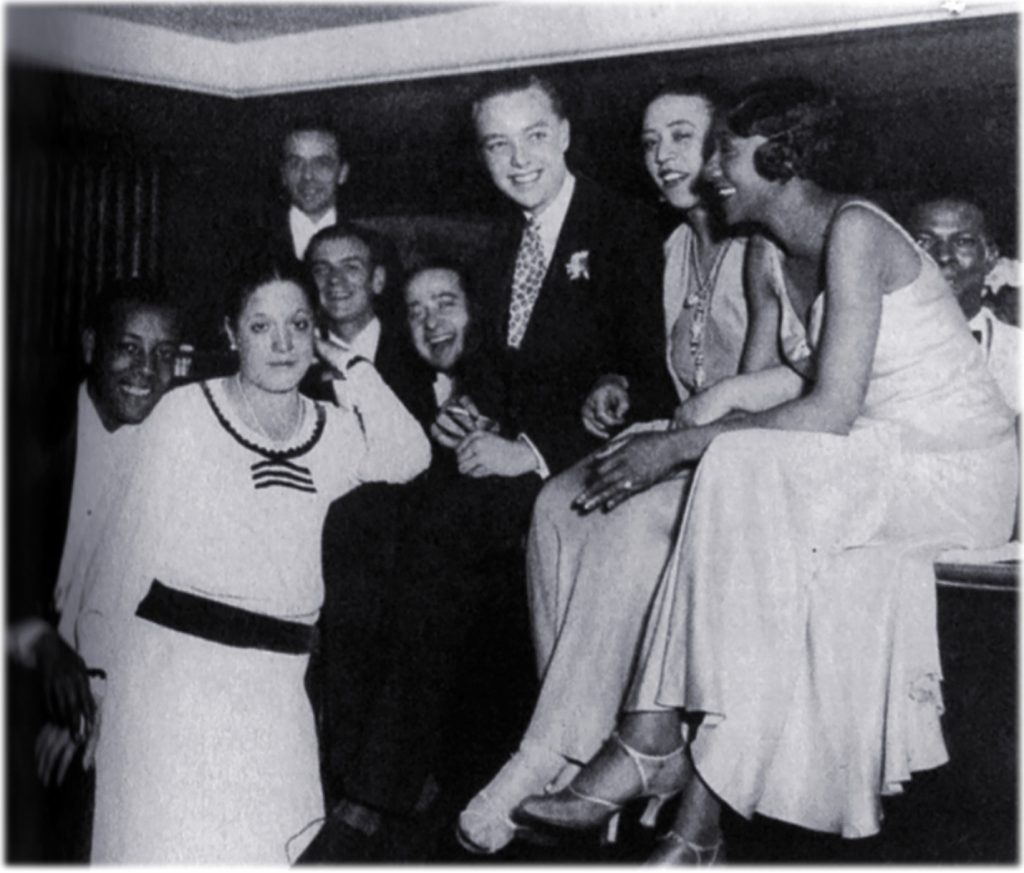

For more see:
Josephine Baker’s Banana Skirt Dance
https://youtu.be/L9jNCm6CVV0
FranK Goudie’s Paris
http://www.jazzhotbigstep.com/137101.html
Frank Goudie in Paris
http://www.jazzhotbigstep.com/752934.html
Thanks for posting this. Hard Rock was huge in early 70’s when I was in high school in Georgia which seven then had plenty of racial prejudices to cope with. The Rock music from those times often seemed to me as self-absorbed, obnoxiously grating noise. Discovering Jazz was a joy and sounds of Count Basie, Duke, Lester and Billie became my music of choice. Explored French Jazz scene with Django Reinhardt my gateway musician from the time. No surprise many African Americans who could left the states for country where they were less segregated and more appreciated. Many good reads on Jazz. Robert Gottlieb’s “Reading Jazz” abounds with conversations from collection of well-known Jazz personalities, and although not focused upon the golden age of French Jazz, it is a book I recommend wholeheartedly.
I found most of the audio links to be BUNK (and not “Johnson”), just unable to produce any audio.
Sorry to hear that Mugg. Perhaps if you try another browser, or computer instead of cell phone? Best
Errors: The Grand Duc was launched by Louis Mitchell in 1923 and the management was assumed by Gene Bullard in December. Florence and Palmer only performed there. He left in February 1924, and she left in March. Neither had any connection with the Crackerjacks or the Boeuf sur le Toit.